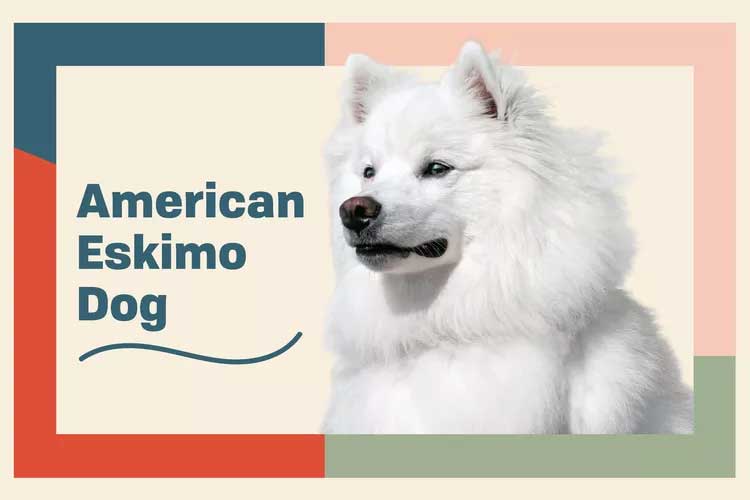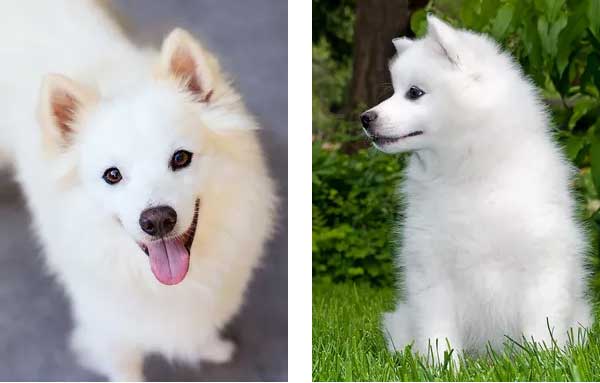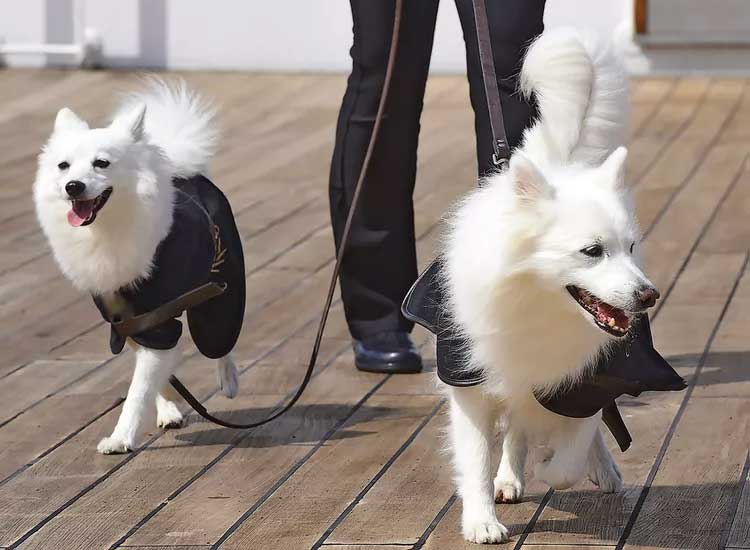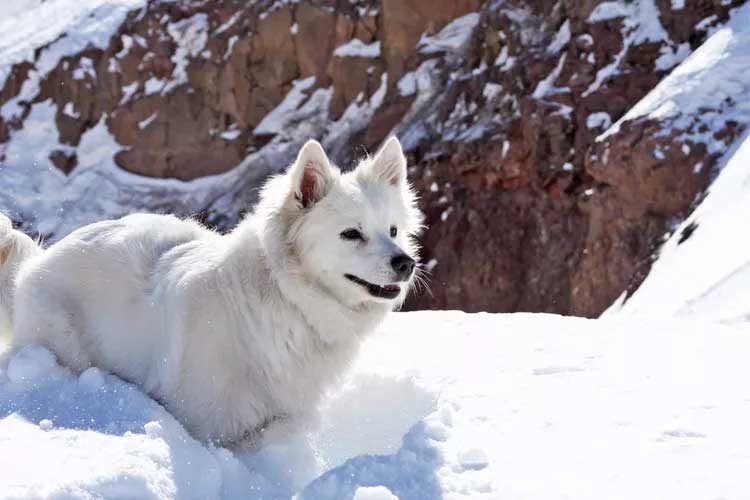American Eskimo dogs are intelligent, energetic pups with fluffy white coats. They are easily trainable and highly loyal to their owners.

American Eskimo Dog Overview
| OFFICIAL NAME | American Eskimo Dog |
| COMMON NAME | American Eskimo Dog |
| PET HEIGHT | 9 to 19 inches |
| PET WEIGHT | 6 to 35 pounds |
| LIFESPAN | 13 to 15 years |
| GOOD WITH | cats, children, dogs, families |
| TEMPERAMENT | friendly, gentle, outgoing, playful, protective |
| INTELLIGENCE | high |
| SHEDDING AMOUNT | frequent |
| EXERCISE NEEDS | high |
| ENERGY LEVEL | active |
| VOCAL LEVEL | when necessary |
| DROOL AMOUNT | low |
| BREED GROUP | non-sporting |
| BREED SIZE | small (0-25 lbs.) |
| COAT LENGTH | long |
| COLORS | cream, white |
| PATTERNS | bicolor |
| OTHER TRAITS | apartment-friendly, easy to groom, easy to train, good for first-time pet owners, highly territorial, high potential for weight gain, strong loyalty tendencies, tendency to chew |
If you're looking for a spunky and highly intelligent dog that resembles the fluffiest of clouds, you'll instantly fall in love with the American Eskimo dog. Also known as the Eskie, these charming small dogs are loyal to their owners, making them a great option for families.
Widely known as one of the most trainable dog breeds, Eskies gained popularity in the late 1800s and early 1900s when they were used in traveling circus acts to perform impressive agility stunts. Full of energy, personality, and affection, these sweet companion pups can adapt to busy, hectic households with ease and love to be the center of attention.
Appearance
American Eskimo dogs come in three sizes: toy, miniature, and standard. Toy Eskies can be as small as 6 pounds, and standard ones can weigh up to 35 pounds. Although Eskies look quite similar to Samoyeds, they're much smaller in both height and weight.
Known for their thick, shiny white coat, the American Eskimo dog just naturally gives off a joyful, radiant look. "The brightly appointed white coat, upright fur-tufted ears, gorgeously plumed tail that is carried over the back, and eye-catching pigmentation convey intelligence and command instant attention," says Theresa Wright, Ph.D., an American Kennel Club-registered American Eskimo breeder, and author of The Dog Beautiful.
Their famously fluffy coats are actually double coats: a dense undercoat and a longer outer coat that require frequent brushing to keep shedding under control. Their black noses, lips, and eyes stand out against their light coat, giving them an approachable and friendly face, and the ruff around their chest and shoulders can give them a ferociously cute lion-like appearance.
Eskies almost exclusively have bright white coats, but they can occasionally have cream-colored markings. Their strong, compact, and muscular bodies make them capable of performing agility skills, and they move with an adorably confident and spry gait.
Temperament
High-spirited and cheery, American Eskimo dogs make great companion pets because of their well-behaved and friendly disposition. They're loyal to their humans and have a gentle temperament, so they make excellent family dogs and do well around children.Eskies are a sensitive breed that are completely devoted to their families. As with any dog, Wright finds: "They understand human intonation and words. They appear capable of relating to the social nature and emotional stresses of our lives."
Any Eskie owner will quickly learn, these dogs have high energy levels and exercise needs, so it's crucial for owners to take them on walks each day. If their energy needs aren't met or they spend too much time alone during the day, American Eskimo dogs can get bored and exhibit undesirable behaviors such as digging or chewing. During playtime, you'll want to interact with them and guide their exercise.

"Giving them structured or directed exercise (for example, directing their exercise, giving it purpose) works much better and is more rewarding for them than letting them run around indiscriminately for the full exercise time," Wright says. Try agility training, puzzle toys, or hide-and-seek games to keep your Eskie on his toes.
Because they are so loyal to their families, American Eskimo dogs can be a bit shy and apprehensive around strangers. They will let their voice be heard if they sense danger for their family, so don't be surprised if your Eskie barks at the delivery person or someone walking down the road.
Living Needs
Because Eskies are so attached to their families, they are definitely indoor dogs and don't like being left outside by themselves in the backyard. Therefore, these little guys can make great apartment dogs, provided they're walked regularly.If you're in a lively, rambunctious household, good news—your Eskie will thrive! Because of their activity needs, being in a house with lots of little kids running around can actually help them work out all their energy.
Thanks to their double coat, Eskies absolutely adore cold climates. In fact, Wright says, "In snow storms, they can use their feathered tails to cover their faces." In warmer climates, their white coat reflects the sun, cooling them off naturally. "As long as they have some shade and plenty of water, they do well," Wright says.
Care
Because of their double coat, you might assume Eskies are hard to keep clean, but they actually require a reasonable amount of grooming. You'll only have to bathe them once every few months, otherwise their skin can get dry and irritated. If they happen to get dirty, just run a brush through their coat and the dirt should come right off.Speaking of brushing, it's important to note that Eskies shed ... a LOT. Make sure you're brushing them two to three times a week to remove dead hair and prevent any matting. Regular nail trims, ear checks, and teeth brushing are also a good idea.

Eskies have the stellar reputation of being one of the easiest dogs to train. In fact, during the days of traveling circuses, American Eskimo dogs were a staple of the highly entertaining trained dog acts. As with all dogs, early socialization and puppy training classes are important. You can (and should!) start training your American Eskimo puppy the day you bring him home.
Like all breeds, American Eskimo dogs respond best to positive reinforcement with ample praise, lots of treats, or their favorite toy. Get them used to leash walking early as well. Because they're so eager to please their humans, it won't be long before your Eskie wants to put on a show and demonstrate their skills to the family whenever prompted.
Health
With access to a veterinarian and quality nutrition, American Eskimo dogs can enjoy a long, healthy, and happy life. They often reach 15 years without any serious health problems; however, owners should be aware of some genetic health problems that Eskies can inherit.
According to the American Eskimo Dog Club of America, two of the most common health risks associated with American Eskimo dogs are hip dysplasia, which can cause your dog's thigh bone not to fit properly in their hip joint, and progressive retinal atrophy, which is the deterioration of the retina over time.
It's common for American Eskimo dogs to become calmer and less playful as they get older, so don't stress if they aren't as energetic as they enter their senior years. American Eskimo dogs can become overweight, particularly in their senior years, so make sure to closely monitor your dog's food intake and weight throughout his life.
History
When German immigrants came to the United States in the 1800s, they introduced Americans to a small, lively dog breed named the German spitz. According to the American Kennel Club, spitzes are Nordic dogs with fox-like faces, and although they're known to come in many different colors, Americans preferred the white coat. The white-colored German spitz was the variation that would eventually be known as the American Eskimo dog.By the late 19th century, the beautiful white coats on German spitzes attracted the attention of traveling circuses that were traversing the nation, and because of their high intelligence and trainability, they quickly became the star of many circuses' dog acts, according to the breed club. Families watched in awe as these majestic-looking dogs jumped through hoops and easily followed the cues of ringmasters. This led to widespread popularity of the breed throughout the early 1900s.

When anti-German sentiment started building as the United States entered into World War I, American owners of the German spitz started calling their dogs American spitzes, and then eventually American Eskimo dogs. Despite what their name suggests, American Eskimo dogs have nothing to do with the Indigenous group of people that inhabit Eastern Siberia, Alaska, and northern Canada. It's believed the dog's snow-colored coat led to the misnomer.
It's clear the American Eskimo dog has a colorful and lively history in the United States, but it wasn't until 1995 that they became an officially registered dog breed with the AKC.
Fun Facts
The most famous circus-performing Eskie is most likely a dog named Pierre, who traveled with the Barnum & Bailey Circus as a tightrope walker. Talk about agility!Despite their confusing name, American Eskimo dogs are not meant to be sled dogs. In fact, the German spitz (the breed they originated from) were utilized for herding, hunting, and guarding livestock.
Four different American Eskimo dogs played the hilariously named Kevin in the 2009 romantic comedy The Proposal. You might remember the scene where Sandra Bullock's character tries to feed poor Kevin to an eagle who steals her cell phone. Don't worry—no Eskies were harmed in the making of this movie!